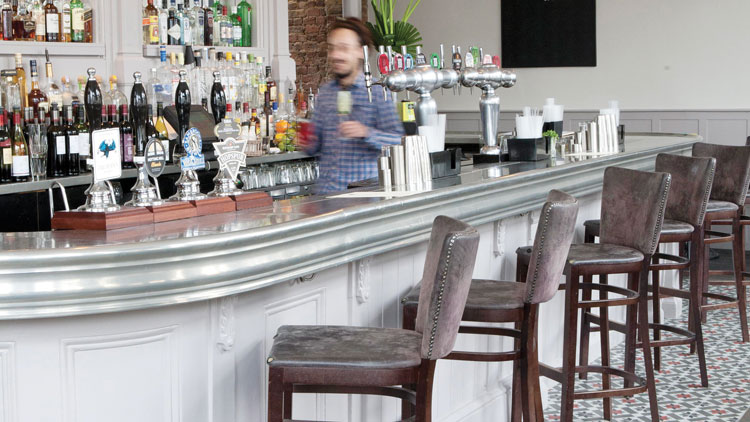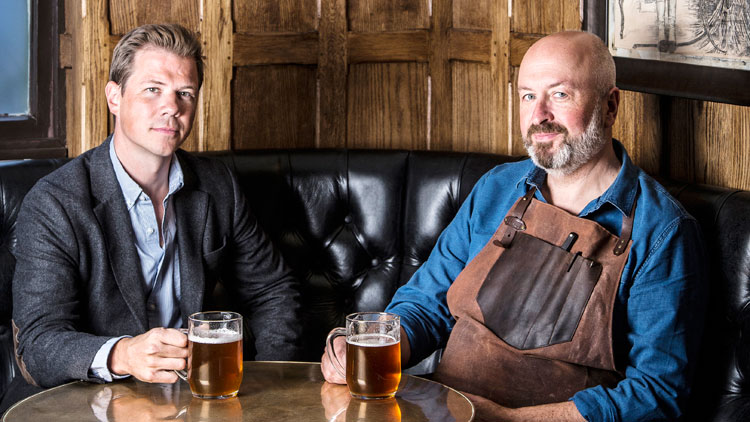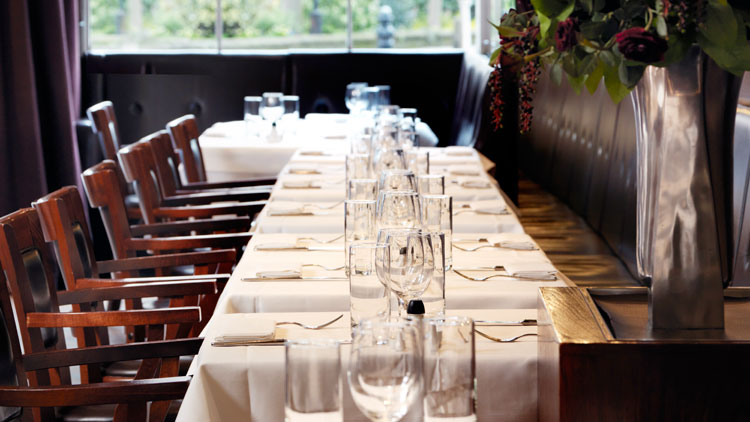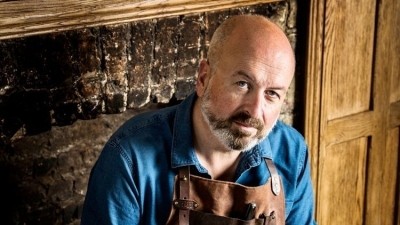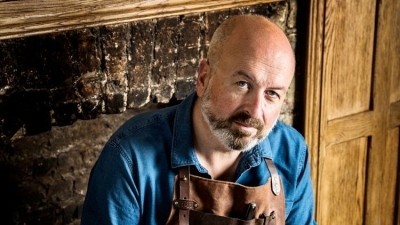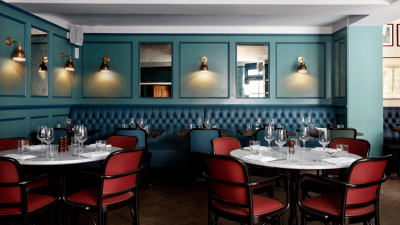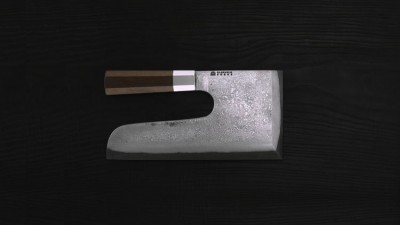Henry Harris: why the former Racine chef is bringing bourgeois food to the pub
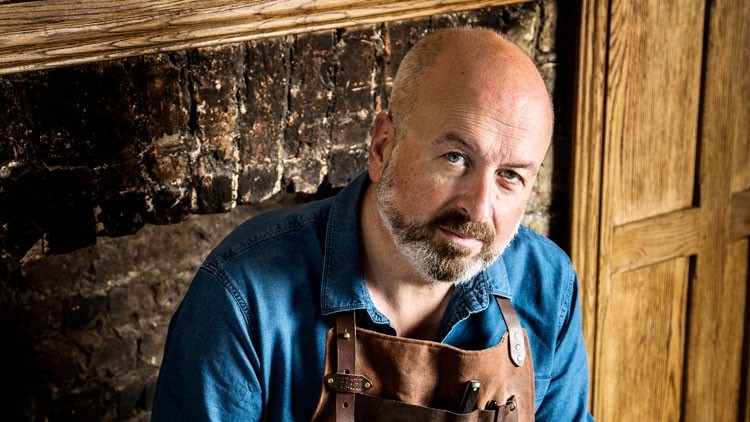
With a loud thud, Henry Harris puts down his large roll of knives on the table, unwraps it and starts picking thoughtfully through the various blades. Out comes one particularly sharp looking knife, its blade wrapped in yellowing newspaper, which he lays down in front me, followed by a mean looking meat cleaver and then another knife with its blade sheathed in an old broadsheet.
Then there’s his prized possession, a small hunting knife that he momentarily takes from its leather holder and brandishes at me before putting it back. That one, he says, is for carving game birds.
Things continue in this vein for a couple more minutes as more and more knives are placed carefully on the table so that soon it looks like we’re on the film set of Lock, Stock and Two Smoking Barrels – Dexter Fletcher’s line “guns for show, knives for a pro,” springing to mind. There’s a beautiful filleting knife, its blue handle made with pine cones set in resin and then polished to resemble fish scales and a carving knife that looks like it could do some damage. And then there’s the four steak knives that he’s made himself and which he shows off proudly. “The day I took them home I went straight out and bought a couple of côte de boeufs and made the family sit down to a punishing steak dinner so they could eat with the knives dad made,” he says.
Harris, as you will have gathered by now, is something of a knife obsessive. He talks of the time a chef who used to work with him put a picture on Instagram of some beautifully cooked beef, but all Harris could see was that it had been cut with a knife that wasn’t sharp enough. He admits his nights are often spent on internet knife forums honing his knowledge of blades and has around 100 or so of them kicking around the house – some rolled up in the attic, others in random cupboards – because he can’t bring himself to throw any away. “I’ve kept everything from back when I was a student at Leith’s, including four carbon-steel Sabatier knives.”
Twenty of these knives are really cherished and used, including ones from famed Oregon knife maker Murray Carter. “If you talk to someone interested in knives and you mention Murray Carter they go ‘oh, I’ve always wanted to see one of his knives’. I’ve got three,” he says with obvious pride. And he knows each one as if they were his children. His gyuto knife has some scratches on it, but he says he knows exactly where they are and how they came about. I’m starting to wonder whether, in the event of a fire, it would be his children or his knives that he would save first.
None of this will be a surprise to anyone who knows Harris, and many in the industry do. The 54-year-old much-loved chef has had a distinguished career working first alongside Simon Hopkinson at his restaurant Hilaire before he installed him as sous chef at Bibendum. Later, he made a name for himself at his first head-chef gig at Harvey Nichols’ Fifth Floor restaurant. After a decade there he moved on again, this time to Racine in Knightsbridge, where he famously carried out his brand of bourgeois French cooking until the restaurant closed in January 2015.
Harris is known not just for his obsessive tendencies but for his deep-rooted love of French food (writing in The Guardian, Tim Hayward described him as “the best French chef with the decency to be British”) and his extensive knowledge of classical cooking. He is a chefs’ chef through and through – when talking about putting an express lunch menu on at Racine he cuts himself off and says “of course, lunch should never be express”, a belief most old-school chefs still hold dear.
After Racine’s closure he kept his hand in with work at The Groucho Club before embarking on a number of consultancy projects, as well as an aborted pub partnership, but has remained absent from the capital’s dining scene in any meaningful way. But now he’s back, and once again he means business.
We meet in The Harcourt, a pub in Marylebone owned by Holborn Leisure Group. The reason for the location is that Harris is working with Holborn Leisure to oversee the food offer at its new portfolio of pubs – The Harcourt being the exception. The company will later this year reopen The Three Cranes pub in Mansion House followed by The Coach & Horses in Clerkenwell early next year, with Harris in charge of the food at both.
Moreover, he will also write the menus at The Truscott Arms, the Maida Vale pub that closed in 2016 after licensees Andrew and Mary-Jane Fishwick lost an 18-month legal battle over a £175,000 rent hike, but which will reopen with a full refurb under a new name in January or February next year. The group is also taking on the Kensington Park Hotel in Ladbroke Grove, due to reopen next spring, and is also believed to be involved in the acquisition of Carvosso’s at 210, the bar and restaurant based on Chiswick High Road, for yet another opening, although it is keeping tight-lipped about the latter two.
The idea is to build a group of food-led pubs that stand out, according to James McCulloch, director at Ducalian Capital, which backs Holborn Leisure. “We want to build a group of people who really understand pub food,” he says. “I go to lots of pubs and they are often very generic, the food is burgers and fish and chips. We want to create something more interesting, And Henry is perfect. He likes simple ingredients that work perfectly in a pub setting.”
Harris was initially approached by McCulloch on a consultancy basis, but now has the title of chef director, with a more hands-on role across the group. “They were looking for someone to devise menus for them as they grow,” says Harris. “It’s good to have a consultant, but on the days I’m not there who do you turn to if you’ve got a problem? If I’m working on someone else’s clock I can’t come and resolve it. I told them they needed someone who will manage their food and beverage offer.”
The switch from running a Knightsbridge neighbourhood restaurant to pubs might not seem obvious, but Harris insists it is something that has been on the cards for a while.
“When I sold Racine I really thought its momentum would pick up and it would be reborn and open within six months, but in a different neighbourhood,” he recalls. “I describe London as being a network of villages and I thought I’d move to a different one and would just change the style [of the restaurant] so it would be more relaxed and casual – getting rid of table cloths, using simple glassware, having more casually dressed waiting staff, but serving similar food at the right price point for the neighbourhood.”
This dream quickly fizzled out, however, with the first location Harris settled on coming to nothing. As the search for a site continued, he realised the best way of doing it might be to open in a pub. “Pubs are to the British what brasseries are to the French – a bar and restaurant together. I like the idea that people come in for a drink and an hour and a half later feel a bit peckish and they don’t have to go any further than the dining room. The French use the term restoration – the art of restoring someone through the provision of good food and drink. Pubs can do that.”
And by a pub, he means a pub, rather than a restaurant in a former pub building. “There are some beautiful places around where people walk in and go ‘this isn’t a pub’. You can spend a lot on them or very little; neither guarantees success or brings on failure, but you have to remember what a pub is about. It must serve a good pint, have wine starting at a reasonable price and affordable food. Prices can then go up for people who want to make more of an occasion of it, but you should be able to go in and just have a good beer.”
This realisation led Harris to take up the reins as chef-patron of Buckinghamshire pub and restaurant The Dog & Badger, a position that proved short lived, with the chef at the time citing ‘artistic differences’ with the owner as the reason for the split before it had even opened its doors. “We went into partnership but ultimately couldn’t agree on how that would be,” is as much as he will be drawn on the matter. Yet, rather than dampen his enthusiasm for pubs, the experience galvanised him. “From there, I knew pubs were exactly what I wanted to do,” he says.
His next attempt at getting behind the stove of a pub was even less successful. Harris had intended to take on a pub in Fulham that was once chef Paul Merrit’s The Farm but had since gone through a number of changes, the last incarnation being in the style of the New York subway system. Harris had the bank loan in place and was ready to sign on the dotted line before issues with the housing association directly behind the pub, and then with the landlord over costs and the state of the building, made him eventually walk away from the deal. So when McCulloch came knocking it was too good an opportunity to pass up.
What really attracted Harris to the deal was the set-up. As any restaurant chef who has made the switch to pubs will tell you, most pubs already in existence were not created to serve the number of covers that many owners now require from them. Kitchens are often tiny, an afterthought to the (once) much more important cellar and drink storage areas, with very little space for prep.
This has been addressed with the redevelopment of the three pubs, with kitchens redesigned and menus created to suit each’s capabilities. At The Truscott, the space has been rearranged so that it no longer has a service kitchen in the basement as well as a small first floor kitchen but rather the basement has been opened up to house a bigger and better-equipped cooking area.
“In a really busy service they will have needed to use both those kitchens and have a chef oversee the quality of food coming from two separate rooms, which is not ideal. They were probably using slightly more people than they needed to. We are being commercially minded when we are planning the kitchen and back-of-house areas to make the most efficient use of labour and by extension make them better places to work.”
Each kitchen will have a simple solid top range, a gas or electric hob, a griddle plate and a robata grill, says Harris, who has chosen that particular piece of kit over the more en vogue Josper grill. “I’m sure it’s a useful piece of kit but there is something about grilling behind closed doors that isn’t my cup of tea. The whole design of the robata seems to work exceptionally well.”
The Three Cranes will have two small dining rooms and a small kitchen that will be built around the grill after the company discovered a planning application from 1911 for a grill room. “That’s what I want to do,” says Harris, who plans to run a 4/4/4 menu of items such as lamb and veal chops and grilled whole fish.
“The menu will be small and manageable. It is easier for storage if there’s less ingredients, and easier to maintain quality and oversee it. It also makes commercial sense if you’ve got a smaller menu and less stuff, and that’s without even going into the skills shortage.
“There’s not enough space in the kitchen for sauce making so in all likelihood I’ll just serve chops with some flavoured butters and mustard. Starters could be tomato salad, terrine and egg mayonnaise. It will be run like those neighbourhood bistros in France where there’s only a chef and a plongeur – and when they are not washing up they are helping to plate up. Puddings will be cheese, chocolate mousse or ice cream. We will be keeping it really simple.”
The wine list at The Three Cranes will also reference the pub’s past. Named after the three cranes of timber on nearby Vintry wharf once used to bring Bordeaux wine casks out of the vessels (confusingly, the pub’s former sign depicted three birds) – the pub will have a strong Bordeaux wine focus.
Fans of Harris' food will celebrate he's staying true to his cooking style of the past decade. At Racine he was renowned for his classic French cooking that did the simple things expertly, such as calf’s brain with black butter and capers; or veal kidneys with Roquefort butter and pomme purée. Smears, centrifuges and frippery have never been his thing.
“If you spend eight years working for Simon Hopkinson he will teach you to respect the ingredients and cooking technique and the origins of a dish and not mess around with the things that work,” he says. Calves liver, for example, must be properly cooked in foaming butter rather than scorched on a grill, he states. “There are people who’d disagree with me but putting calves liver on a grill is a mistake; it burns the blood and makes it bitter. Bathing it gently in butter gives it a softer texture and flavour and an elegance. All you need is a
pile of watercress or a nice grilled tomato – providing it is a good tomato – and some English mustard on the side.”
So will the food at the pubs, in particular The Truscott Arms, be predominantly French? The short answer is no. “As French as Racine was I always gave it some strong British elements, but I just dressed it up as French,” says Harris, who says the menus will have a British and European feel, albeit with a French accent.
“I love French food so there is going to be those influences there. We’ll have duck confit, choucroute, steaks with bearnaise sauce, but at the same time good sausage rolls. There are plenty of pubs serving food with strong European influences and where you can get roast beef on a Sunday but also pasta and risotto and I am just going to the narrow the breadth of that.”
Harris also wants to distance the places from the gastropub moniker, but rather present them as pubs with dining rooms. As such, you won’t find dishes such as Goan monkfish curry on the menu, or indeed fish and chips (except maybe on a Friday). “I’m avoiding the ‘g’ word,” he says.
So classic Racine dishes will appear on the menu. Is there a danger that people will get the wrong impression about the pubs? “People will come in and say ‘it’s not Racine’, expecting it to be. In the same way when I opened Racine and people came in and said it wasn’t like Harvey Nichols and where’s all the fancy stuff? But it will only be a few people.”
Is he not worried, however, about entrusting his dishes to different chefs? Harris was a near-constant presence in the Racine kitchen but with his time split over three sites (and more in the future) he faces the challenge of chefs being able to execute his food to his famously high standards.
“There’s always the question ‘who cooks the food when you’re not there?’ It’s the same people who cook it when I am. I oversee it. There’s a chain of command that ensures the team works together. The key to successful implementation and execution of the food will be finding chefs to run those kitchens who share my philosophy and love of food and welcome and enjoy the process of working with someone as much as for them to develop the menus.”
That said, certain Racine dishes will unlikely transfer over because Harris’ gaze will be elsewhere. He talks of a saffron and garlic mousse with a mussel butter sauce that was “delicate, fragile and incredible savoury”. “Would that be on the pub menus? It might be on for day or two if I’m in the kitchen supervising or if one of my former chefs comes on board who I trust cooking it, but otherwise no.” The same goes for Racine’s now legendary creme caramel, which took him six months to perfect.
“There were times at Racine when I had to take a dish off because I felt people couldn’t do it consistently well,” he adds. “It’s a challenge every restaurateur and publican faces.”
With a few months to go before the first pub opens, Harris will no doubt be spending his time working out how he can overcome this, and other challenges, he will face as a pub chef. That and sharpening his knives.
This is a web version of an article that first appeared in the September issue of Restaurant magazine, the leading title for the UK's restaurant industry. For more features, comment, interviews and in-depth analysis of the restaurant sector subscribe to Restaurant magazine here
